Note: This product was purchased by me personally. No payment (or even contact) was made by the company, other than to state my order was received and the tracking info on the shipment. This is an unbiased, unpaid opinion. MY opinion.
I was talking on the phone with BlueTang about jerky, as he had just made a batch. He wasn’t happy about it, having followed a recipe he found on the internet. I tried it, and thought it was OK, though was missing several levels of flavor. He then went on to explain how he’s spend years trying to come up with great jerky, BBQ, or smoking recipes, only to find that the pre-packaged stuff seasonings almost always had done the work, so were just simpler to rely on.
Mind you, his level of acceptance and mine are light years apart…what he makes for me to try as he “perfects” his cooking I consider fantastic, and typically better than most restaurants I’ve tried. He, however, thinks it “still needs something”, and keeps working at it, and constantly “bothering” me to try yet another one of his recipes. Ribs, sausages, dried salamis, jerky, bacon…the list goes on and on, and being the good friend I try to be, I always try some, go back for seconds, and give him my honest opinion….usually punctuated with “more please”.
So BT was unhappy with his jerky, and was going on about how great Hi Mountain, a meat product seasoning company, had spice recipes that have already been proven, and were such solid products to use, and how he planned on getting around to ordering some buckboard bacon and some jerky spices some day. Taking this as an opportunity to score some points with my meat-providing friend, I went ahead and purchased some stuff for him…and some jerky seasoning kits for me while I was there.
The two I purchased were the Mesquite Blend and the Hickory Blend Jerky kits. So far, I’ve only tried out the hickory. Here are my thoughts on it.
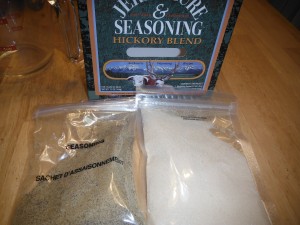 First, nice packaging…on the outside. Inside merely holds two sealed plastic bags, a spice shaker, and the instruction. I guess I shouldn’t expect anything more, but the fancy box made me think there would be some jerky-making tree-dwelling elf, or possibly a sample or two already made and included. No so. But not a big deal.
First, nice packaging…on the outside. Inside merely holds two sealed plastic bags, a spice shaker, and the instruction. I guess I shouldn’t expect anything more, but the fancy box made me think there would be some jerky-making tree-dwelling elf, or possibly a sample or two already made and included. No so. But not a big deal.
I opted for a whole muscle jerky vs. ground meat, as I get a larger yield. I found bottom round on sale ($2.59 a pound!), purchasing 6 pounds of it. I sliced it with the grain into 1/4inch+ slabs of meat, about the size of a slice of bread. (Mmmmmm meat bread!)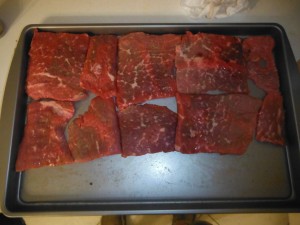
Using the directions, based on weight, I mixed up the spices and the cure, then put it into the provided shaker bottle. Being sure to only use half, I sprinkled it across one side. Then, flipping each piece over, I sprinkled the remaining spices of the other side. I then placed all of the seasoned and cured covered meat into a gallon ziplock bag and mixed everything around, trying to get an even spread of the spiced throughout. 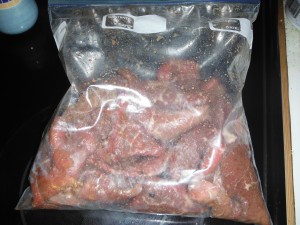 Placing the bag o’ meat into the refrigerator, I then cleaned up a bit (though never quite enough for the wife) and did the hard part – I waited 24 hours. This gives the spices time to permeate the meat with its tastliliciousness as well as time for the cure to start to do its salty, microbe killing magic.
Placing the bag o’ meat into the refrigerator, I then cleaned up a bit (though never quite enough for the wife) and did the hard part – I waited 24 hours. This gives the spices time to permeate the meat with its tastliliciousness as well as time for the cure to start to do its salty, microbe killing magic.
Sodium Nitrite
Too much sodium nitrite, one of the main ingredients in the included curing agent, isn’t good for us…but it is even worse if you are Clostridium botulinum . In proper dosages, provided via the directions, the cure helps prevent botulism, and as a lucky side affect, gives meat a rich, full red color as well as an added salty taste. Sodium nitrtite also delays the development of lipid oxidation (fats going bad), considered to be a major reason for the rancidity and unappetizing flavors. Nobody likes the taste of rancid meat! (Not that jerky actually gets used as a long-term food around here. We are lucky if a batch of jerky lasts a week!) Incidentally, sodium nitrite, in large enough doses, CAN kill you, so is usually colored pink so as not to be confused with table salt or sugar. But for whatever reason this cure is NOT colored appropriately. Be careful!
From http://www.extension.umn.edu/distribution/nutrition/DJ0974.html:
…the fatal dose of potassium nitrate for adult humans is in the range of 30 to 35 grams consumed as a single dose
To obtain 22 milligrams of sodium nitrite per kilogram of body weight (a lethal dose), a 154-pound adult would have to consume, at once, 18.57 pounds of cured meat product containing 200 ppm sodium nitrite (because nitrite is rapidly converted to nitric oxide during the curing process, the 18.57 pound figure should be tripled at least). Even if a person could eat that amount of cured meat, salt, not nitrite, probably would be the toxic factor.
If I could MAKE 18.57 pounds of jerky, I’d probably eat it…but since the process cuts the weight to as much as 1/4 it original weight, I’d need almost 75 pounds of trimmed bottom round, as well as a walk-in dehydrator or smoke house, and I have neither. I guess I’ll never be able to overdose via jerky….Also the same article states that ingesting vitamin C also offsets sodium nitrite’s adverse affects. So when in doubt while eating lots of cured jerky, drink some OJ with it!
This is the end of the FHB Public Service Announcement regarding the “perils” of sodium nitrite.
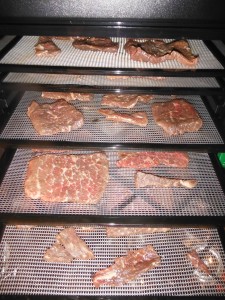 The next day, I happily spread the meat out on to the drying racks of my Excalibur dehydrator. Since this dehydrator offers a wopping 15 square feet of drying space, and I used about half of the racks, I had about 7 square feet of jerky set up to dry! Have you ever heard of someone referring to jerky by the square foot?
The next day, I happily spread the meat out on to the drying racks of my Excalibur dehydrator. Since this dehydrator offers a wopping 15 square feet of drying space, and I used about half of the racks, I had about 7 square feet of jerky set up to dry! Have you ever heard of someone referring to jerky by the square foot?
Notice the marbling on the meat to the left. This is not an optimal thing for jerky due to fats increase chance of spoilage. Knowing the speed that it is consumed in my house, I wasn’t worried. It would be lucky to actually cool off from the drying process before it gets eaten. Some batches never even make it to packaging.
Setting the dehydrator thermostat on the highest setting, I again did the hard thing, and walked away. It would take at least 8 hours to start getting dry enough to call itself jerky, and as thick as some of the cuts were, possibly double that. So off I went to write about rabbit cages as my Monday post. That occupied me enough that by the time I was done, it was time to sleep.
The following morning, the house smelled like a giant bag of warm hickory smoked jerky. It was horrible! I couldn’t get dressed fast enough to run across the house to get a taste of that mouth-watering smell! My mouth was actually watering as I opened the dehydrator to see the results. The thinner pieces were done enough to eat, so I did, right then and there. I munched on jerky the rest of the morning, and took some to work as a road snack. I couldn’t wait to let BT try some. Everything should be done my the time I got home from work that afternoon.
(The two pieces I took for road snacks lasted about 8 minutes from my house.)
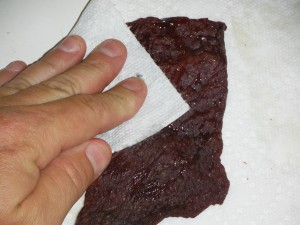 Several hours later, I pulled the remainder of the jerky out, extremely happy with the results. Even the thickest pieces were so dry as to be almost brittle, just the way I like my jerky. Using a paper towel to blot off the rendered grease, I marveled at the color and smell. (Only good manners kept me from licking off the grease!)
Several hours later, I pulled the remainder of the jerky out, extremely happy with the results. Even the thickest pieces were so dry as to be almost brittle, just the way I like my jerky. Using a paper towel to blot off the rendered grease, I marveled at the color and smell. (Only good manners kept me from licking off the grease!)
Using a pair of kitchen shears, I cut each piece into manageable strips, then allowed everything to cool as I organized my sealing equipment.
For optimum long-term jerky storage, put your jerky into vacuum bag with an oxygen absorber, then vac-seal the bag. Throw it in a cool dark place (good), the fridge (better), or the freezer (best). The directions state that all jerky should be stored in the fridge or freezer. I believe that was put there by lawyers protecting the company.
So let me state that while my long-term jerky is stored in the freezer, the method used to make jerky produces a product that is shelf stable at normal room temperatures, as long as it is relatively free from fats. Historically, jerky was stored in the open, no freezers, but freezing, or even chilling prolongs the life and maintains the quality of the product. I am not suggesting storing it anywhere but in cold storage of some type. The fact that, in actual practice, my methods may differ, should have no bearing on what you do. Put yours in cold storage. (The closest thing to a lawyer that I have is a subscriber, and should approve of my wording. Hey B!)
So, to the product review. Hi Mountain Hickory Blend Jerky Kit
The directions were clear. The process was simple. The flavor was GREAT, possible the best jerky I’ve made. BT was right when he said they “have it right”. If I have any complaints, it would be simply that the cure is not colored pink for safety.
Each “kit” includes spices, cure, and a shaker bottle along with clear directions. Hi Mountain produces a simple, yet affective product. Each package is good for 15 pounds of muscle meat, or
I paid $7.95 plus shipping direct from the manufacturer. I believe that you can find this at brand at sporting goods stores as well.
The final verdict was when I gave some to BT, and he tried it. The way it was gobbled up, there is no doubt as to his opinion. My wife ate some, and while she only a single piece, she asked me to make some ground-meat jerky with those spices (its a texture thing with her!) My kids scarfed it up. The neighbor girl ate all she could steal from me. It was an overall 100% hit.
And today is Wednesday. I only have a single bag left already!
Time to make more!
Peace,
db

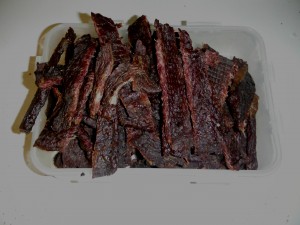
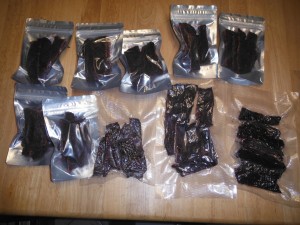
Extremely informative article. Been wanting to get a dehydrator for a long time. I love jerky but avoid frequent consumption because of the sodium nitrate. Thanks for the info.
I’m eating some right now…and calling it “breakfast”!
From the resources I mentioned, vitamin C offsets a lot of the bad stuff sodium nitrite does to us, so eat more jerky, just drink some OJ with it…or a twist of lime….hmmm lime-flavored jerky…..
You’re good.
Thanks B. I’m glad you approves of my writing and editorial methods. 🙂
I use the hi mountain kits also . Everyone that has tried my jerky (and I mean everyone) says the same thing to me -“you should be selling this stuff ” . I smoke mine a little bit in my digital masterbuilt electric smoker and just let it dry out / continue the cooking process in there . For years I’ve been using top round steaks . I’ve tried pretty much every cut of meat and always thought the top round steaks make the best jerky , and that’s what I’ve been sharing with friends and family . I don’t think of myself as an expert jerky maker but the hi mountain kits I feel are the reason it turns out so good . I had tried all sorts of recipes before I got into using the hi mountain products but once I used hi mountain I never went back to other recipes . It is a very popular product . Very nice review of it .
It was easy to give a good review, its a tasty product!
Thanks for the comments!
db